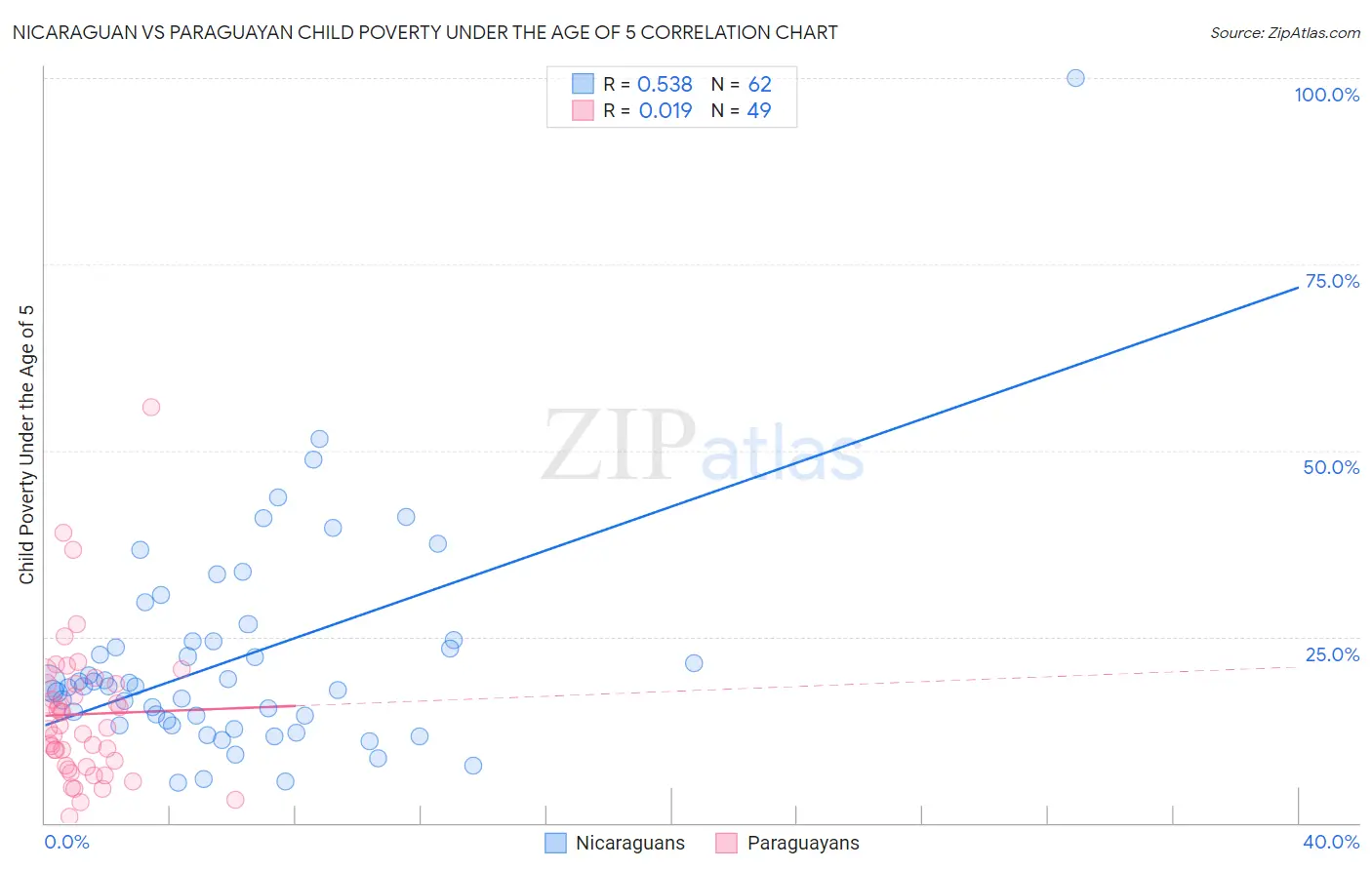Nicaraguan vs Paraguayan Child Poverty Under the Age of 5
COMPARE
Nicaraguan
Paraguayan
Child Poverty Under the Age of 5
Child Poverty Under the Age of 5 Comparison
Nicaraguans
Paraguayans
19.1%
CHILD POVERTY UNDER THE AGE OF 5
1.6/ 100
METRIC RATING
224th/ 347
METRIC RANK
15.0%
CHILD POVERTY UNDER THE AGE OF 5
99.4/ 100
METRIC RATING
59th/ 347
METRIC RANK
Nicaraguan vs Paraguayan Child Poverty Under the Age of 5 Correlation Chart
The statistical analysis conducted on geographies consisting of 279,523,506 people shows a substantial positive correlation between the proportion of Nicaraguans and poverty level among children under the age of 5 in the United States with a correlation coefficient (R) of 0.538 and weighted average of 19.1%. Similarly, the statistical analysis conducted on geographies consisting of 93,489,303 people shows no correlation between the proportion of Paraguayans and poverty level among children under the age of 5 in the United States with a correlation coefficient (R) of 0.019 and weighted average of 15.0%, a difference of 27.4%.

Child Poverty Under the Age of 5 Correlation Summary
| Measurement | Nicaraguan | Paraguayan |
| Minimum | 5.4% | 0.83% |
| Maximum | 100.0% | 55.8% |
| Range | 94.6% | 54.9% |
| Mean | 22.0% | 14.6% |
| Median | 18.4% | 12.8% |
| Interquartile 25% (IQ1) | 13.8% | 7.6% |
| Interquartile 75% (IQ3) | 24.4% | 18.7% |
| Interquartile Range (IQR) | 10.7% | 11.1% |
| Standard Deviation (Sample) | 14.6% | 9.9% |
| Standard Deviation (Population) | 14.5% | 9.8% |
Similar Demographics by Child Poverty Under the Age of 5
Demographics Similar to Nicaraguans by Child Poverty Under the Age of 5
In terms of child poverty under the age of 5, the demographic groups most similar to Nicaraguans are Nigerian (19.1%, a difference of 0.030%), Immigrants from Eritrea (19.1%, a difference of 0.050%), Cuban (19.1%, a difference of 0.11%), Alsatian (19.1%, a difference of 0.13%), and Cape Verdean (19.1%, a difference of 0.23%).
| Demographics | Rating | Rank | Child Poverty Under the Age of 5 |
| Immigrants | Africa | 4.6 /100 | #217 | Tragic 18.6% |
| Delaware | 3.4 /100 | #218 | Tragic 18.7% |
| German Russians | 3.0 /100 | #219 | Tragic 18.8% |
| Immigrants | Azores | 2.6 /100 | #220 | Tragic 18.9% |
| Immigrants | Nigeria | 2.1 /100 | #221 | Tragic 19.0% |
| Alsatians | 1.7 /100 | #222 | Tragic 19.1% |
| Cubans | 1.7 /100 | #223 | Tragic 19.1% |
| Nicaraguans | 1.6 /100 | #224 | Tragic 19.1% |
| Nigerians | 1.6 /100 | #225 | Tragic 19.1% |
| Immigrants | Eritrea | 1.5 /100 | #226 | Tragic 19.1% |
| Cape Verdeans | 1.4 /100 | #227 | Tragic 19.1% |
| Immigrants | Sudan | 1.3 /100 | #228 | Tragic 19.2% |
| Ghanaians | 1.2 /100 | #229 | Tragic 19.2% |
| Ecuadorians | 1.2 /100 | #230 | Tragic 19.2% |
| Bermudans | 1.2 /100 | #231 | Tragic 19.2% |
Demographics Similar to Paraguayans by Child Poverty Under the Age of 5
In terms of child poverty under the age of 5, the demographic groups most similar to Paraguayans are Immigrants from Russia (15.0%, a difference of 0.090%), Swedish (15.0%, a difference of 0.15%), Egyptian (14.9%, a difference of 0.20%), Immigrants from Pakistan (14.9%, a difference of 0.28%), and Danish (14.9%, a difference of 0.35%).
| Demographics | Rating | Rank | Child Poverty Under the Age of 5 |
| Immigrants | Serbia | 99.5 /100 | #52 | Exceptional 14.9% |
| Luxembourgers | 99.4 /100 | #53 | Exceptional 14.9% |
| Immigrants | Israel | 99.4 /100 | #54 | Exceptional 14.9% |
| Danes | 99.4 /100 | #55 | Exceptional 14.9% |
| Immigrants | Pakistan | 99.4 /100 | #56 | Exceptional 14.9% |
| Egyptians | 99.4 /100 | #57 | Exceptional 14.9% |
| Swedes | 99.4 /100 | #58 | Exceptional 15.0% |
| Paraguayans | 99.4 /100 | #59 | Exceptional 15.0% |
| Immigrants | Russia | 99.3 /100 | #60 | Exceptional 15.0% |
| Immigrants | Poland | 99.1 /100 | #61 | Exceptional 15.1% |
| Immigrants | Eastern Europe | 99.1 /100 | #62 | Exceptional 15.1% |
| Immigrants | Europe | 99.1 /100 | #63 | Exceptional 15.1% |
| Immigrants | Romania | 99.1 /100 | #64 | Exceptional 15.2% |
| Immigrants | Fiji | 99.0 /100 | #65 | Exceptional 15.2% |
| Immigrants | Scotland | 99.0 /100 | #66 | Exceptional 15.2% |